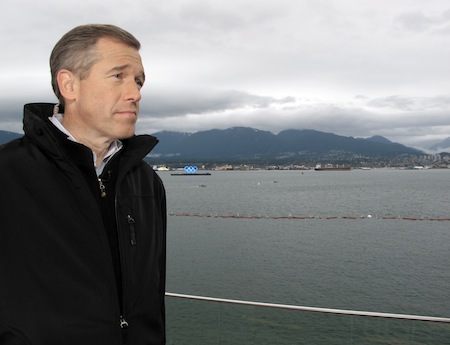'B&C' Hall of Fame: 25 Years of News

As B&C gets set for its 25th Hall of Fame ceremony on Oct. 20 at New York's Waldorf Astoria, we are taking a look back at the many ways the medium of television has changed as a business and as a part of culture. Today's installment: the news business.
The last generation of news anchors as stars began in the early 1980s (inspired by the alpha example: Walter Cronkite) and ran through the early 2000s with Tom Brokaw, Peter Jennings and Dan Rather.
Tom Brokaw took over as anchor of NBC Nightly News in 1982 and retired in 2004—replaced by Brian Williams (more on that later).
Peter Jennings helmed ABC News’ nightly newscast from 1983 to 2005. His successors had much shorter runs. Elizabeth Vargas, Bob Woodruff and Charles Gibson filled the seat at different points for the next few years. Diane Sawyer followed from 2009 to 2014, after which David Muir took the top spot.
Similarly on CBS, Dan Rather had over a two-decade run as anchor of CBS Evening News, anchoring from 1981-2005 (Connie Chung co-anchored from 1993-1995). Rather had arguably the toughest task in replacing the legendary Walter Cronkite.
Bob Schieffer served as a stop-gap between Rather and Katie Couric’s run from 2006-2011, the first woman to anchor a network newscast alone. Scott Pelley has held the position since 2011.
Rather’s departure from CBS Evening News emphasized the vanishing of star anchors, with the final blow coming this year as Brian Williams fell from grace.
The smarter way to stay on top of broadcasting and cable industry. Sign up below
A segment from Rather that appeared on 60 Minutes II in 2004 questioned then-President George W. Bush’s service in the National Guard, which was later found to be based on false documents.
Nearly 10 years later and broadcast’s best hope for a star anchor has been forced out of his job and transferred to MSNBC for another journalistic sin: lying.
Williams was suspended for six months this February for fabricating an experience in 2003 during the Iraq War, a story he had told multiple times. Williams claimed a helicopter he was aboard had come under fire, a “conflation” which he has now recanted.
Lester Holt, who had been the interim anchor while Williams was serving his suspension, was named the permanent replacement in June. NBC News eventually reassigned Williams to MSNBC, which he started Sept. 22.
The downfall of the nightly news star is not due to a lack of capable new anchors or credibility. The difference between 1991 and today is similar to the differences in most sectors of the TV industry between then and now: options.
There are whole worlds of options available now that were either in early stages or hadn’t really been considered.
Cable News Network, the first 24-hour news channel, launched in 1980 through the efforts of founder Ted Turner, who already had success with the first cable TV network in TBS.
Though the network struggled to keep up with its more established competitors, CNN made a name for itself in 1986 with its coverage of the Challenger disaster and again in 1991 with its live coverage during Desert Storm.
Its biggest competitors, Fox News and MSNBC, debuted in 1996.
Fox News launched under Rupert Murdoch and Roger Ailes’ guidance, branding itself the “fair and balanced” network in opposition to the other biased liberal networks.
Microsoft and NBC teamed up to launch MSNBC. NBC bought out Microsoft’s share of the network later and finally parted ways in 2012. The three networks came to epitomize news as entertainment with an emphasis on personality.
CNBC, HLN (formerly CNN2), Bloomberg, Fox Business Network, ABC News-Univision venture Fusion, Glenn Beck’s TheBlaze, and Al Jazeera America have also contributed to the wealth of options available to news-hungry viewers.
In addition to other news networks, broadcasters now have to vie for the attention of millennials with satirical news programs like The Daily Show and social media like Twitter with newsfeeds that can look like news tickers during high-profile events.
Cronkite was often billed as “the most trusted man in America,” and while trust might not have eroded between anchor and viewer, it’s hard to be any version of “The Man” when the viewing options are practically endless.
